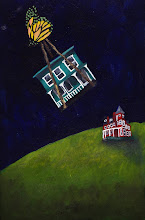

According to Joseph Campbell, you can tell what a culture values by its largest building. The Pharaoh wanted a big tomb, so Ancient Egypt is defined by the pyramid. The Middle Ages brings the rise of the cathedral. France has Versailles. And the United States? The mall. The same holds true for the history of art. The market oftentime prevails and what sells determines what gets created.
If the patron directs architecture and art with funding, it is the modern-day curator who sets the standard. Curators hit celeb status with the rise of contemporary art. Gallery owners Leo Castelli, Ivan Karp, Mary Boone became all-powerful in shaping the NYC art scene, but it was Philippe Montebello who established the bar for high culture with his 30 year tenure as director of the Metropolitan Museum. His modern art counterpart, curator Henry Geldzahler, seen here with me in 1984 at a show he curated at PS 1 in Queens, NY, was part of the Metropolitan's goal of adding contemporary art to their collection, joining their curatorial staff in 1960 at the age of 24. Over the next twenty-five years, with the weight of the Metropolitan Museum's name behind him, Geldzahler's choices of what would grace gallery walls would serve as a primer on late 20th century art. Andy Warhol, Jasper Johns, Frank Stella, David Hockney-- Geldzahler determined the who's who of the era, but the real question is who was left out?





2 comments:
Who WAS left out indeed?! I think there were some pretty good picks there myself!
Lila Ferraro
Queen Bedroom Sets
I know what you mean. Those conceptual years in the 80's were lean times for figurative painters.
Post a Comment